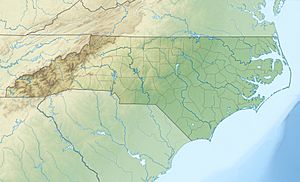Pilot Creek (Ararat River tributary) facts for kids
Quick facts for kids Pilot Creek |
|
|---|---|
|
Location of Pilot Creek mouth
|
|
| Other name(s) | Tributary to Ararat River |
| Country | United States |
| State | North Carolina |
| County | Surry |
| Physical characteristics | |
| Main source | Chinquapin Creek divide pond about 0.25 miles southeast of Pilot Mountain, North Carolina 1,205 ft (367 m) 36°22′42″N 080°27′08″W / 36.37833°N 80.45222°W |
| River mouth | Ararat River about 5 miles east of Pine Hill, North Carolina 838 ft (255 m) 36°20′53″N 080°31′14″W / 36.34806°N 80.52056°W |
| Length | 5.44 mi (8.75 km) |
| Depth |
|
| Basin features | |
| Progression | generally southwest |
| River system | Yadkin River |
| Basin size | 7.19 square miles (18.6 km2) |
| Tributaries |
|
| Bridges | Snuffbox Lane, Leonard Road, Seven Springs Lane, Sandtrap Lane, US 52, Black Mountain Road, Boyd Nelson Road, Shoals Road, Jim McKinney Road |
Pilot Creek is a stream in Surry County, North Carolina. It is about 5.44 mi (8.75 km) long. This creek flows into the Ararat River.
About Pilot Creek
Pilot Creek is an important part of the water system in Surry County. It helps carry water from higher areas down to larger rivers. This creek is a "tributary," which means it's a smaller stream that flows into a bigger one.
Where Does Pilot Creek Start and Go?
Pilot Creek begins in a pond. This pond is located near Pilot Mountain, North Carolina. It is about 0.25 miles southeast of the mountain.
From its start, Pilot Creek flows mainly towards the southwest. It travels through the land until it reaches the Ararat River. The place where Pilot Creek joins the Ararat River is about 5 miles east of Pine Hill, North Carolina.
What is Pilot Creek's Watershed Like?
The area that drains into Pilot Creek is called its watershed. This watershed covers about 7.19 square miles (18.6 km2) of land. This means all the rain and snow that falls in this area will eventually flow into Pilot Creek.
The watershed gets a good amount of rain each year. It receives about 47.8 inches of precipitation annually. A large part of this area is covered by forests, with about 60% of the land being wooded. These forests help keep the water clean.



